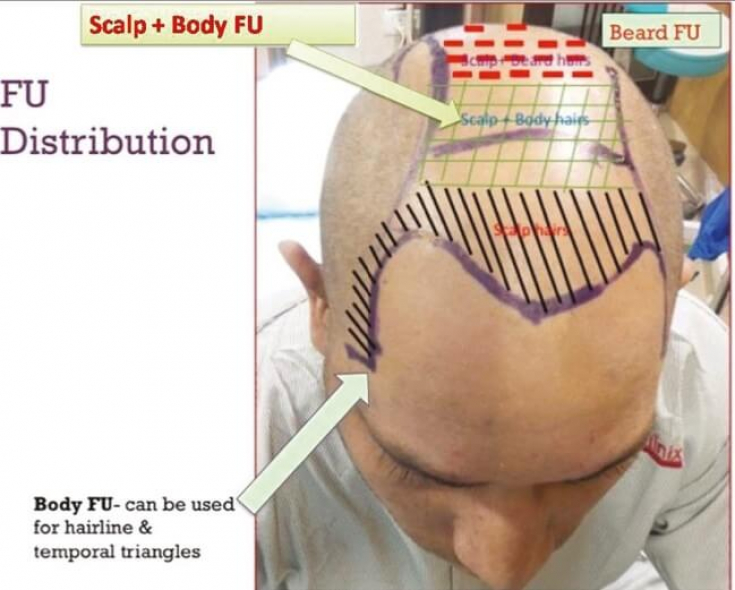For high grade alopecia (Norwood 5–7) hair restoration is considered difficult due to disparity between the balding area and the donor area.
In this article on estet-portal.com you can find a comprehensive methodological approach to manage these cases.
With the right tactic of hair distribution on the scalp, with the help of transplantation, even patients with total baldness can be helped.
The purpose of this article is to evaluate the results and problems associated with follicular unit extraction (FUE) and to plan for the successful treatment of alopecia in the advanced stages.
- Possibilities of the FUE method in the treatment of severe alopecia
- Severe androgenetic alopecia is no longer a sentence
- Secrets of successful F hair transplantationUE
Possibilities of the FUE method in the treatment of severe alopecia
A retrospective analysis of 820 male patients with progressive baldness (grade 5–7) who were treated with the FUE method (follicular unit extraction) was performed by Indian trichologists .
The patients were divided into five groups depending on the degree and localization of alopecia. Results were analyzed at 6, 9, 12 and 24 months.
Read the latest articles in Telegram!
After 12 months, 94% of patients were satisfied with the results, while 62% would like to re-transplant to increase hair coverage/density.
Researchers have concluded that hair transplantation can produce natural and aesthetic results even in severe baldness.
Hair from the beard and body area can be used to improve results in cases where there is a lack of donor hair.
A formed hairline with adequate density in gradient, from front to back, helps to achieve a satisfactory result even in extensive cases of baldnessia.
What you need to know about the hair follicle: morphogenesis, structure and regeneration of hair
Severe androgenetic alopecia is no longer a sentence
For androgenetic alopecia the only permanent solution available is hair transplant.
Follicular Unit Extraction (FUE) has evolved significantly as the latest advance in minimally invasive surgical hair restoration.
Instead of removing a large area of scalp skin for FU harvesting, in the FUE technique individual follicular units are removed from the donor area using a punch biopsy.
This procedure leaves virtually no scarring, and thus creates a natural, aesthetically pleasing result.
A beacon of hope for alopecia areata patients
Successful hair restoration for advanced baldness has been found difficult due to the mismatch between the graft site and the donor area. But there is a solution to this problem.
Firstly, hair from the beard and body can be used for transplantation, and secondly, even the formation of natural hairline in front can significantly improve the appearance of patients
Secrets of Successful FUE Hair Transplant
Based on the availability of donor grafts, we can plan
coverage.
Requires a minimum of6000 grafts for full coverage, 4500–5000 grafts anterior and midfrontal coverage, 3000–3500 frontal coverage > grafts.
In patients with severe alopecia and a limited donor area on the head, it is necessary to enlarge the donor area with alternative donor areas (eg beard / body). In most cases, 1000–1500 grafts can be removed from a beard.
Best method of using head, beard and body hair:
- Frontal hairline — head hair;
- Top — mixture of head and body hair;
- Nake — mixture of head and beard hair;
- Body hair can be used to soften the hairline and temporal triangles.

Results of a single FUE treatment for Norwood class 5 hair loss
Secrets of a successful FUE procedure:
- quick graft harvesting with minimal trauma;
- constant hydration and storage of grafts in specialized solutions at all stages;
- reduce "out-of-body storage time" transplants;
- implantation "without touching the root";
- Maintain implantation density at 35–40 FU/cm2 for the frontal region with decreasing gradient from the frontal hairline to the apex (20–25 FU/cm2);
- safe dose of anesthetic;
- well-coordinated teamwork.
realistic hairline, assessing the quantity and quality of donor hair follicles depending on where they are taken: the head, beard or body.
 Results of a single FUE session for Norwood 6th class baldness 9 months after the procedure
Results of a single FUE session for Norwood 6th class baldness 9 months after the procedure
limiting the use of anesthesia, when possible, helps to prevent a number of complications.
Constant hydration of grafts, reducing their "out of body" time; and the method of implantation "without root touch" increases their survivability.Thus, recent advances in FUE have made
treatment of even grade 7 hair loss a reality.
Minoxidil under the gun: drug options for hair loss







Add a comment